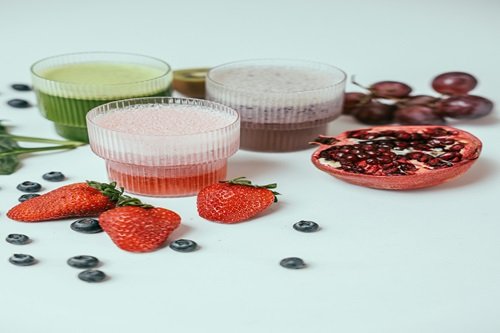The Protein Boom in 2025
In 2025, protein has evolved from a gym essential to a mainstream cultural icon. You’ll find it in everything—cereal, ice cream, popcorn, smoothies, and even coffee creamers. Social media feeds are packed with “30g of it breakfasts,” celebrity-endorsed snacks, and fitness influencers swearing by their daily intake. But beneath the glitz and gym selfies, an important question arises: Is the protein craze actually worth it?
In this article, we break down what science, dietitians, and certified trainers are saying about the trend that’s redefining fitness and nutrition.
What Sparked the Obsession?
Protein has always had a foundational place in fitness, but in recent years, its status has skyrocketed due to:
- Social media fitness trends promoting “protein goals”
- Celebrity influence, with figures like Khloé Kardashian launching protein snacks
- Consumer health shifts, including the rise of muscle preservation, longevity, and high-protein meal plans
More than just a muscle-building tool, it is now marketed as the key to fat loss, energy, skin health, and anti-aging. The hype has reached a point where “protein-rich” is seen as synonymous with “healthy”—regardless of the product’s actual nutrition quality.


What Does Protein Do in the Body?
it is a macronutrient made of amino acids—building blocks your body uses to repair muscles, create enzymes and hormones, and support immunity. It plays a critical role in:
- Muscle growth and repair
- Metabolism and satiety (feeling full)
- Tissue maintenance
- Immune system support
So yes, it is essential. But that doesn’t mean more is always better.
How Much Protein Do You Actually Need?
The Recommended Dietary Allowance (RDA) for sedentary adults is 0.8 grams per kilogram of body weight (about 56g/day for men, 46g/day for women). However, active individuals and athletes may benefit from 1.2–2.2 grams/kg depending on training goals.
🚫 The Myth: “You need 150g+ of it daily to lose fat and build muscle.”
✅ The Truth: Most people get enough from a balanced diet. Overconsumption can be excessive, costly, and unnecessary.
Read: What is 75 hard challenge? | HOW YOGA BENEFITS YOU IN EVERYDAY LIFE | WHAT IS CARB CYCLE – FAST FAT BURNING PROCESS! | Fittheories
The Benefits of a Higher-Protein Diet
1. Muscle Preservation During Fat Loss
Studies show that during calorie deficits, increasing protein can help maintain lean muscle mass.
2. Improved Satiety and Appetite Control
it is more satiating than carbs or fats, helping people feel fuller longer and possibly reducing overall calorie intake.
3. Supports Strength Training Results
In combination with resistance training, increased protein intake can lead to improved strength and lean body mass.
4. Helps With Aging and Recovery
Older adults benefit from higher protein to prevent muscle wasting and support recovery after illness or injury
Potential Risks of Protein Overconsumption
Like all good things, taking it in excess can backfire. Here are some concerns from research and health professionals:
❗ Kidney Stress
Too much can overwork the kidneys, especially for those with pre-existing issues.
❗ Dehydration
Protein metabolism requires more water. Without proper hydration, high-protein diets can lead to dehydration.
❗ Nutrient Imbalance
Obsessing over it can mean neglecting fiber, antioxidants, and essential micronutrients from fruits, vegetables, and whole grains.
❗ Ultra-Processed Foods
Many protein-labeled snacks are packed with sugar, additives, and artificial sweeteners—contradicting the goal of eating “clean.”
Trendy Doesn’t Mean Healthy: The Problem With “Protein-Washing”
In 2025, brands have capitalized on the trend by adding minimal protein to products and labeling them as “high-protein.” This marketing tactic, called protein-washing, is misleading consumers.
Common culprits include:
- Protein chips with more sodium than nutrition
- Protein cereals loaded with sugar
- Bars with 20g protein… and 300+ calories from processed fillers
Just because something has protein doesn’t mean it’s healthy.


Whole Foods vs. Supplements
While protein shakes and bars are convenient, whole-food sources are superior for digestion, nutrient density, and long-term health.
✅ Best Whole-Food Protein Sources:
- Chicken, turkey, eggs
- Lentils, beans, chickpeas
- Greek yogurt, cottage cheese
- Tofu, tempeh, quinoa
- Fish and seafood
🥤 When to Use Protein Powders
Supplements can be useful:
- After intense workouts
- When you’re on the go
- For people with increased needs (athletes, elderly, recovering from illness)
Choose third-party tested, low-ingredient powders to avoid contaminants and fillers.
Who Really Needs More it?
| Group | Reason |
|---|---|
| Athletes & bodybuilders | To support muscle repair and hypertrophy |
| Older adults | To prevent muscle loss (sarcopenia) |
| People in a calorie deficit | To maintain lean mass while cutting fat |
| Pregnant or breastfeeding women | To support fetal and infant development |
The 30-30-30 Rule: Does It Work?
Popularized on TikTok, the 30-30-30 rule recommends:
- 30g protein
- Within 30 minutes of waking
- Followed by 30 minutes of light exercise
While this morning routine can promote fat loss and stable blood sugar, there’s no magic to these numbers. It simply emphasizes protein timing and movement—both helpful habits, but not revolutionary.


How to Approach Protein in 2025 (and Beyond)
Here’s how to benefit from it without falling into the hype:
- Know Your Needs
Use body weight and activity level to set realistic protein goals (e.g. 1.2–2.0g/kg for active people). - Prioritize Whole Foods
Get most of your protein from unprocessed sources for better nutrient balance. - Watch for Marketing Tricks
Don’t fall for snacks labeled “protein-rich” without checking the sugar, fat, and ingredients. - Use Supplements Wisely
Keep protein powders as a supplement—not a meal replacement—unless recommended. - Balance Your Plate
Even with high protein, make room for vegetables, healthy fats, and fiber.
Final Verdict: Is the Protein Craze Worth It?
✅ Yes, if:
- You’re training regularly and need muscle repair or strength support.
- You’re recovering from illness or trying to preserve lean mass.
- You use high-quality protein sources in reasonable amounts.
❌ No, if:
- You’re sedentary and already meet your nutritional needs.
- You’re consuming mostly processed products.
- You’re chasing numbers without understanding your body’s needs.
It is a powerful tool, not a silver bullet. When used wisely, it supports performance, recovery, and long-term health. But when blindly over-consumed or misrepresented through marketing, it becomes another empty trend.
So the next time you see a “protein donut” or “protein water,” ask yourself—does it serve your goals, or just the trend?


Read: Food with low carbs | Carb Cycle | Home Workout | Why the 12-3-30 Treadmill Workout Is Going Viral Again in 2025